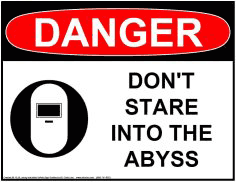Everyone is running out of hope regarding a solution for the economic problems in Europe. A change in government in Greece, the possibility of Berlusconi stepping down are not enough to bring confidence to markets or the public. In the Econ Blogosphere we only see increasing pessimism: Mark Thoma, Barry Eichengreen, Paul Krugman, and many others.
Tim Duy makes the point that so far stock markets, in particular, Wall Street is ignoring the risks that are building in Europe. He draws an analogy to what was going on in 2007 when stock markets were still booming and ignoring the fact that we were literally looking into the abyss but we could not see it. He believes that today Europe is unable to see the abyss ahead of them and Wall Street is ignoring the problem assuming that it will not hit the US.
But what does the abyss looked like in 2007? In 2007 we had built a set of imbalances on asset prices, in particular housing prices that had supported a different imbalance, on spending and debt (private and or public). While some did not want to see the abyss, those who saw it were looking into a fall in asset prices, financial disruption and a sharp fall in economic activity.
What does the abyss look like today for Europe? We know with certainty that there will be partial default in Greece, but as I have argued before this does not qualify as an abyss (for Europe). It is a bump on the road, maybe a big one but not large enough to justify a deep recession in the Euro area. The fear is about others following, in particular Italy and Spain. But here is where the 2011 abyss looks very different from the 2007 one: this time the crisis is much more linked to confidence. In 2007 the adjustment in asset prices was unavoidable. Today, we debate about whether the Italian government or the Spanish government are solvent and the answer is much less clear. Why? Because solvency depends on confidence and confidence depends on how we see solvency. If Italy keep losing the confidence of markets, as it is happening today, then they are insolvent, too big to fail but too big to be rescued.
So if we keep staring at the abyss, we are just making it deeper. And the deeper the abyss is, the more we want to stare into it.

So the solution is to stop staring into the abyss. Given where we are today there is only one way to do that, to have the ECB taking a very aggressive stance on how they are willing to support the governments of Italy or Spain if their interest rates keep increasing. Communication from European governments, over stretching the EFSF is not going to be enough anymore, you need the ECB to stand between us and the abyss so that we stop staring into it.
- Bulenox: Get 45% to 91% OFF ... Use Discount Code: UNO
- Risk Our Money Not Yours | Get 50% to 90% OFF ... Use Discount Code: MMBVBKSM
Disclaimer: This page contains affiliate links. If you choose to make a purchase after clicking a link, we may receive a commission at no additional cost to you. Thank you for your support!



Leave a Reply